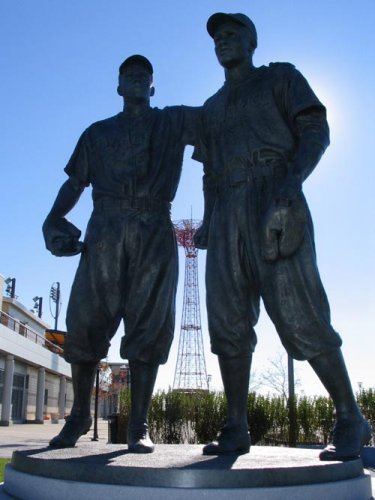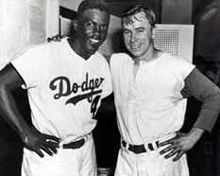Two Men Who Did the Right Thing - Pee Wee Reese and Jackie Robinson

By Ira Berkaw
It was simple on its face, but as deeply layered as the gesture it memorialized.
Yesterday [November 1, 2005], a statue was unveiled in front of a Brooklyn ball field, KeySpan Park, where the Mets' Class A Cyclones play. The statue was not of a general on a horse, or a poet in deep thought (with a pigeon on his head), but of two long-ago baseball players -- Jackie Robinson and Pee Wee Reese of the Brooklyn Dodgers.
On this uncommonly warm, sun-filled fall morning, a crowd of a few hundred had gathered outside the entrance to the park, in front of the statue, which was under a yellow covering. A band of five, wearing ''Brooklyn Sym-phony'' sweatshirts, a nostalgic touch for the Dodger Sym-Phony, a group that once played in long-gone Ebbets Field, struck up several songs, including their classic Three Blind Mice, which paid homage to umpires.
The monument was representative of a time in history, beyond baseball, that in the late 1940's reached to the deepest, the most tragic, and yet the most elevating moments of a nation in racial crisis. Robinson, a black man, was breaking the long-held racial barrier in the major leagues. Reese, from Louisville, Ky., had inherited a teammate whom many people did not want to see play major league baseball.
Both Reese and Robinson are dead. Reese died in 1999, Robinson in 1972, but their widows attended the ceremony yesterday. Rachel Robinson and Dottie Reese were there with their children, as well as Mayor Michael R. Bloomberg; two former Dodgers teammates of Reese and Robinson, Johnny Podres and Joe Pignatano; Jeff Wilpon, senior executive vice president of the Mets; and John Franco, the Brooklyn-born pitcher and a former Met.
The statue captures a significant moment that is much remembered, although the precise details surrounding it are hazy. With Robinson receiving death threats and heckling and taunts from the crowd in a ballpark on the road, Pee Wee Reese walked over to him on the infield at a point either before or during a game and offered a quiet but significant gesture of friendship and comradeship.
"My father had done his own soul searching", said Mark Reese, Pee Wee's son, "and he knew that some fans, teammates, and yes, some family members didn't want him to play with a black man."
"But", Mark Reese added, "my father listened to his heart, and not to the chorus."
He added that his father admired Robinson as a ballplayer and as a man. When a petition was passed around in spring training by some Dodger players saying they would refuse to play with Robinson, Reese declined to sign it. And when the moment came for him to demonstrate his concern for a teammate, in the most subtle but unmistakable fashion, he took it.
The statue shows the two players, with Reese's arm around Robinson's shoulder. There is no photograph of the moment. It is not totally certain if Reese, the shortstop, put his hand on Robinson's shoulder, or his arm around him, or just moved up close to him.
Robinson played first base in his rookie season, 1947, and second base the next year. The statue's first design had Robinson wearing a fielder's mitt. But if the incident took place in 1947, Robinson had to be wearing a first baseman's glove, so the sculptor, Will Behrends, changed the baseball ware. The incident probably happened in Crosley Field in Cincinnati, although another Dodgers teammate, Duke Snider, said he remembered it occurring in Boston.
"I remember Jackie talking about Pee Wee's gesture the day it happened", Rachel Robinson said yesterday. "It came as such a relief to him, that a teammate and the captain of the team would go out of his way in such a public fashion to express friendship."
In the biography Jackie Robinson by Arnold Rampersad, Robinson himself was quoted as recalling the incident this way: "Pee Wee kind of sensed the sort of helpless, dead feeling in me and came over and stood beside me for a while. He didn't say a word, but he looked over at the chaps who were yelling at me and just stared. He was standing by me, I could tell you that."
The hecklers ceased their attack. "I will never forget it," Robinson said.
"Pee Wee thought nothing of it," Dottie Reese said. "For him, it was a simple gesture of friendship. He had no idea that it would become so significant. He would be absolutely amazed." She added, "I just wish he were here today."
Indeed, Reese's gesture did not come from a save-the-world mentality. It was simply the act of a decent man doing the decent thing. In 1997, Reese told The New York Times: "Something in my gut reacted at the moment. Something about what? The unfairness of it? The injustice of it? I don't know."
Bloomberg said that Robinson, like Rosa Parks, who died Oct. 24, was a civil rights hero.
"Jackie was a role model" who, said Bloomberg, went about his life and his athletic pursuits with "style, grace and dignity," and "electrified a nation."
Marty Markowitz, the Brooklyn borough president, said, "When Pee Wee Reese threw his arm around Jackie Robinson's shoulder in this legendary gesture of support and friendship, they showed America and the world that racial discrimination is unacceptable and un-American."
Several of the speakers said they hoped the monument and the memory of that moment would be an inspiration to young people.
It was mentioned during yesterday's ceremony that the memorial came about because Stan Isaacs, a columnist for Newsday, had suggested on a radio show shortly after Reese's death the creation of a statue commemorating the moment. Jack Newfield wrote about the idea in The New York Post, and Rudolph W. Giuliani, the mayor at the time, picked up the momentum. Numerous donors followed suit.
With the speeches ended, the yellow covering was taken off and the statue revealed. There was applause, and some gasps at the startling likenesses of the ballplayers.
Then the Brooklyn Sym-phony broke into Take Me Out to the Ball Game.
This article originally appeared in the New York Times on November 2, 2005


